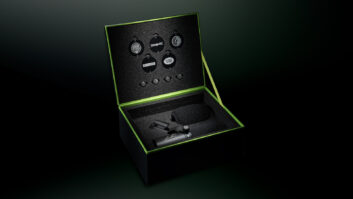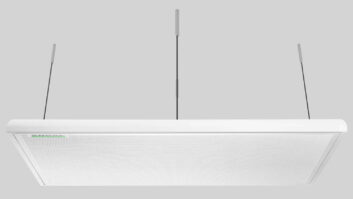After the first week of rehearsal for last year’s k.d. lang
tour, the background singers decided that they would be better off
with in-ear monitors (IEMs). The tour budget had already been set,
but the money saved by sending the wedge monitors back to the
rental company more than paid for the entire IEM rack. In order to
provide dedicated stereo mixes for three background singers, plus a
spare that doubled as my cue mix, I used four Shure PSM400 systems,
supplemented with John Hardy mic preamps and three of TC
Electronic’s affordable M1 reverbs. Compared to Shure’s more
expensive PSM systems, the frequency response of the 400 drops off
a third of an octave earlier, roughly at 12 kHz instead of 15 kHz.
I missed it, but it didn’t bother my singers much. The companding
characteristic (common to all PSM systems), while noticeable under
controlled listening conditions, is acceptable in rock
’n’ roll applications.
The front panel of the Shure P4T transmitter ($470 list) offers
a volume control for local monitoring (via a stereo mini jack),
four-segment stereo metering, a single-digit RF channel indicator,
and a permanently attached, quarter-wave antenna. The half-rack
format allows two P4Ts to be mounted in a single rackspace and,
unlike the previous Shure PSM600 and -700 systems, the P4T uses an
external power supply, so its depth is shortened by three inches.
The 5⅜-inch-deep chassis has extruded aluminum sides similar
to the Lexicon LXP-1, with a single slide-in PC board. The
transformer has two screw holes to mount it; it employs an AC plug
on a cord rather than the common “wall wart” design,
and its chassis connector has a locking ring.
Though there are no XLR connectors, the ¼-inch inputs are
balanced. The transmitter has no Mono/Stereo switch; instead, the
unit automatically switches to mono when only one of the
¼-inch inputs is plugged in. The unit operates at a nominal
0dB input level, and the absence of an input volume control and a
+4/-10 switch effectively prevents these controls from being set
incorrectly.
The gain structure of wireless in-ear systems dictates that, for
best signal-to-noise figures, they should be driven close to their
clipping points. With no input volume control, keep an eye on the
meters, which aren’t much more than idiot lights similar to those
on power amps. The 400 transmitter does not clip gracefully, so
it’s especially important not to run into the red.
The P4R receiver ($490) is almost half the weight of the
½-pound, metal-bodied PSM600 and -700 receivers (often
referred to as “hand grenades” by performers familiar
with them tugging on their wardrobe). Although I’d guess the
plastic case is not as durable, I’ve seen them take drops and abuse
without failing. Battery life is a healthy eight hours when running
on the recommended Duracell 9-volt, alkaline batteries, and a
three-segment “fuel indicator” icon in the LCD screen
shows the battery life status. Though battery life depends on many
variables, I found that changing batteries every other day was
sufficient enough to get through two soundchecks and two two-hour
shows. When the battery is about to die, the entire LCD screen is
illuminated with a red backlight that is easily noticed by the
user.
The P4R receiver’s controls are two momentary pushbuttons on the
side — labeled Select and Scroll — and an LCD screen on
the top, a layout similar to that found on Shure’s professional UHF
wireless mics. A lockout feature can be used to prevent performers
from unintentionally changing the settings.
As with the other PSM models, a “MixMode” allows the
user to listen to and balance a mono blend of the transmitter’s two
inputs, allowing for a “me vs. them” or “vocals
vs. instruments” self-mixing strategy. The PSM400 also
includes the familiar 6dB boost at 10 kHz and a defeatable
limiter.
PSM400 (and -700) systems operate on one of 16 channels (0
through F), spread across UHF channels 56 to 59. Channels 0 to 4
are in TV 56; 5 to 7 are TV 57; 8, 9 and A are TV 58, and B to F
are TV 59. In cities where one (or more) of these channels are
being used by broadcasters, you’ll want to avoid using the
corresponding PSM400 channels. As for their other wireless
products, a table on Shure’s Website
(www.shure.com/products/frequency/frequency.asp) helps with
frequency coordination in the 30 largest U.S. cities.
One of the useful features of Shure’s PSM700 receiver is a
Frequency Locator Mode feature that turns off the tone squelch,
allowing the operator to listen for interference from outside
sources and verify clear frequencies. Many bands often can’t afford
to carry a frequency analyzer or scanner with them, so this is a
very helpful field tool. A similar feature on the P4R allows it to
be used to scan its 16 channels. To engage this feature, press both
the Select and Scroll buttons while turning the P4R on; the RF icon
on the LCD will scroll, indicating that the tone squelch is off.
The resulting white noise is quite loud, so be careful with the
volume setting. If any sounds can be heard mixed in with the normal
white noise of an open frequency, then there are other
transmissions on that channel. These sounds may be anything from
whistles, tones or rumbles, to the intermodulation product of an FM
broadcast with another PSM transmitter or even the audio portion of
a TV signal.
The P4R receiver is somewhat compatible with the PSM700
transmitter, as its 16 frequencies are the same as the 700’s Group
1. Though the 400 offers 16 frequencies, Shure recommends running
no more than eight simultaneously. This is because the P4R has less
“front end” filtering, resulting in lower RF
selectivity. When employing multiple units, it’s best to skip
channels so that transmitters are not susceptible to
intermodulation. Aside from interference from outside sources, I
had the best luck with channels 2, 4, 6, B and D when using four or
five units together. What with trying to space out channels to
avoid intermods and having to negotiate around TV broadcasts or
other environmental RF, I wouldn’t recommend trying to coordinate
more than five PSM400 systems in a touring situation.
Despite some shortcomings for touring professionals, many
features of the PSM400 make it simple to use. Changing the
frequency on the transmitter is a simple matter of pressing a
recessed button beside the single-digit display to increment the
channel (easily done with the tip of an ⅛-inch plug) and then
holding it in for a moment to set the new frequency. The receiver’s
channel is changed (when unlocked) when the user presses Select and
then scrolls. On the 700, both operations require a tiny
screwdriver, enough light and, if you’re getting on in years, a
pair of reading glasses.
A rugged antenna is permanently attached to the receiver so it
can’t get lost. The transmitter’s antenna is also fixed, which
doesn’t allow users to run multiple units with a combiner and a
single-directional antenna. Because the 400 is designed to be used
with a companion half-rack P4M mixer onstage, this limitation is
understandable. Without the benefit of a combiner or log antenna, I
had occasional problems with dropouts, though my singers were
typically only 30 feet away.
The P4HW hard-wired beltpack ($360 list) suffers from none of
the frequency response or companding problems associated with
wireless. I carried three as backups for the one day on the tour
when I couldn’t use the wireless (BBC: ’nuf said), but my
singers didn’t like having to worry about tripping on the cables
while they danced, so we only used them that one time. For
stationary players like drummers or keyboardists, this hard-wired
beltpack option has both a sonic and a cost advantage. Also,
Shure’s recently unveiled AuxPander, which takes eight inputs from
channel inserts and group outputs on an FOH console to create four
stereo mixes, offers a way to create custom in-ear mixes without a
dedicated monitor console.
All PSM400 products can be bought separately, and, in my
opinion, those shopping for their first in-ear monitor system on a
tight budget won’t find a better value. Professional users with 700
transmitters may also want to use 400 receivers as spares or even
primaries, because their Group 1 is the same frequency set and
they’re less than half the price. The money saved on the economical
PSM400 system can easily pay for Shure’s better two-way E5 ear
piece [reviewed in February 2000 Mix] instead of the
less-expensive E1. The E5 is more rugged and provides greater
sensitivity, extended frequency response and a more enjoyable
listening experience. I got nothing but compliments from my singers
every night, and I found that I needed to do little for them except
find clear frequencies, change batteries and smile.
Shure Inc., 222 Hartrey Ave., Evanston, IL 60202-3696;
847/866-2200; fax 847/866-2279; www.shure.com.
Mark Frink (
[email protected]
) would like to thank Kate
Markowitz, Windy Wagner and Amy Keys, three of the most talented
and professional singers he’s worked with.







